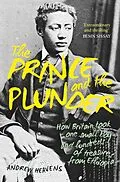'Extraordinary and thrilling ... This story should be known to every man, woman and child' - Lemn Sissay
In 1868, British troops charged into the mountain empire of Ethiopia, stormed the citadel of its monarch Tewodros II and grabbed piles of his treasures and sacred manuscripts. They also took his son - six-year-old Prince Alamayu - and brought the boy back with them to the cold shores of England.
For the first time, Andrew Heavens tells the whole story of Alamayu, from his early days in his father's fortress on the roof of Africa to his new home across the seas, where he charmed Queen Victoria, chatted with Lord Tennyson and travelled with his towering red-headed guardian Captain Speedy. The orphan prince was celebrated but stereotyped and never allowed to go home.
The book also follows the loot - Ethiopia's 'Elgin Marbles' - and tracks it down to its current hiding places in bank vaults, museum store cupboards and a boarded-up cavity in Westminster Abbey.
A story of adventure, trauma and tragedy, The Prince and the Plunder is also a tale for our times, as we re-examine Britain's past, pull down statues of imperial grandees and look for other figures to commemorate and celebrate in their place.
Autorentext
Andrew Heavens is a senior editor at Reuters. Before joining the news desk, he was the agency's correspondent in Sudan and Ethiopia. He grew up in Nigeria, Kenya and Egypt, and lives in London. The Plundered Prince is his first book.
Klappentext
At the dawn of 1868, Britain invaded Ethiopia with 13,000 soldiers and a crack unit of collectors, oddballs and boffins. As the troops advanced, the force's zoologists shot and stuffed anything that moved. Its archaeologists carried out a hit-and-run dig along the way. The British Museum librarian who was hitching a ride on the raid loaded up with crosses and crowns plundered during the mission's final battle. And a red-headed, 6-foot-6-inches intelligence officer called Captain Speedy picked up a young prince called Alamayu and took him back to England.
Andrew Heavens tells the story of what happened next to Prince Alamayu and tracks down the plunder - Ethiopia's 'Elgin Marbles' - in bank vaults, storerooms and a hidden cavity in Westminster Abbey. Part revisionist history, part treasure hunt, this is a tale for our time as we re-examine Britain's past, pull down statues of imperial grandees and look for other figures to commemorate and celebrate.
